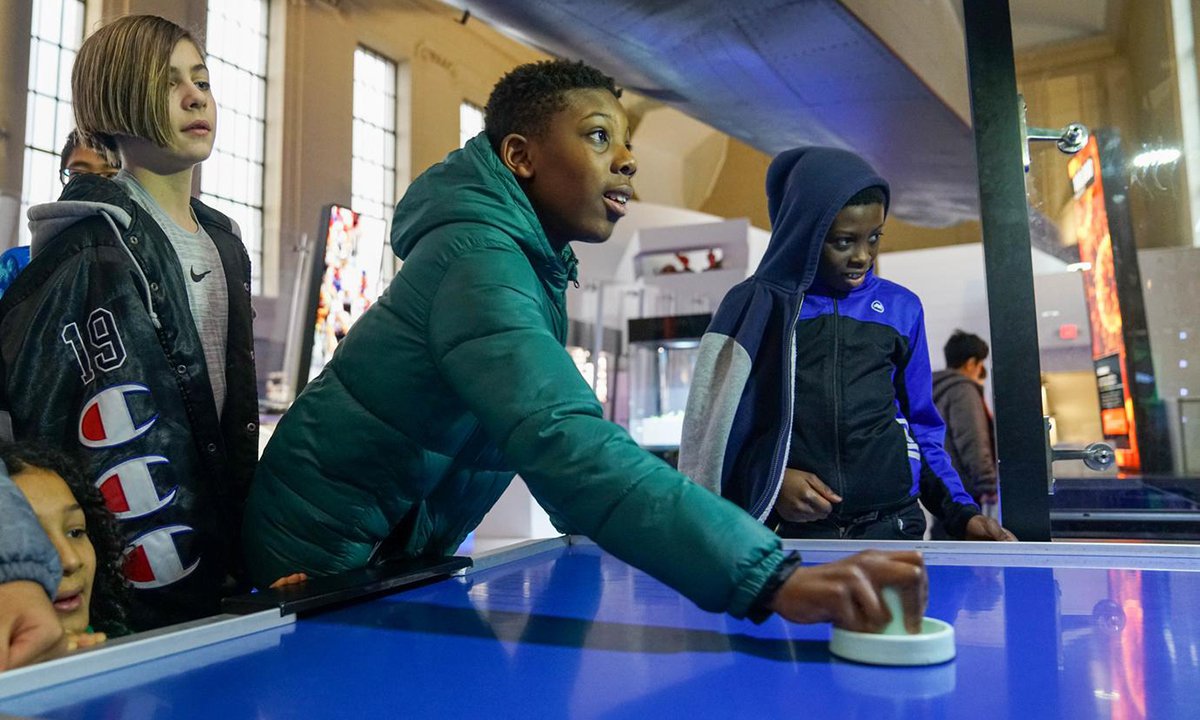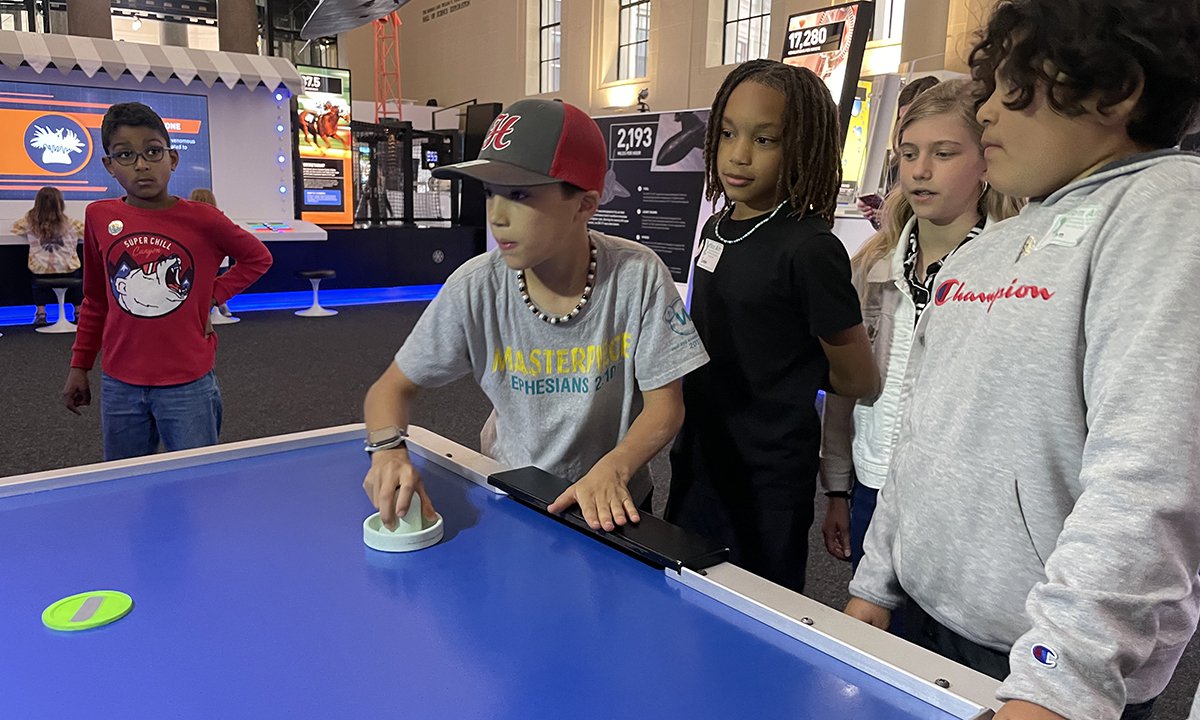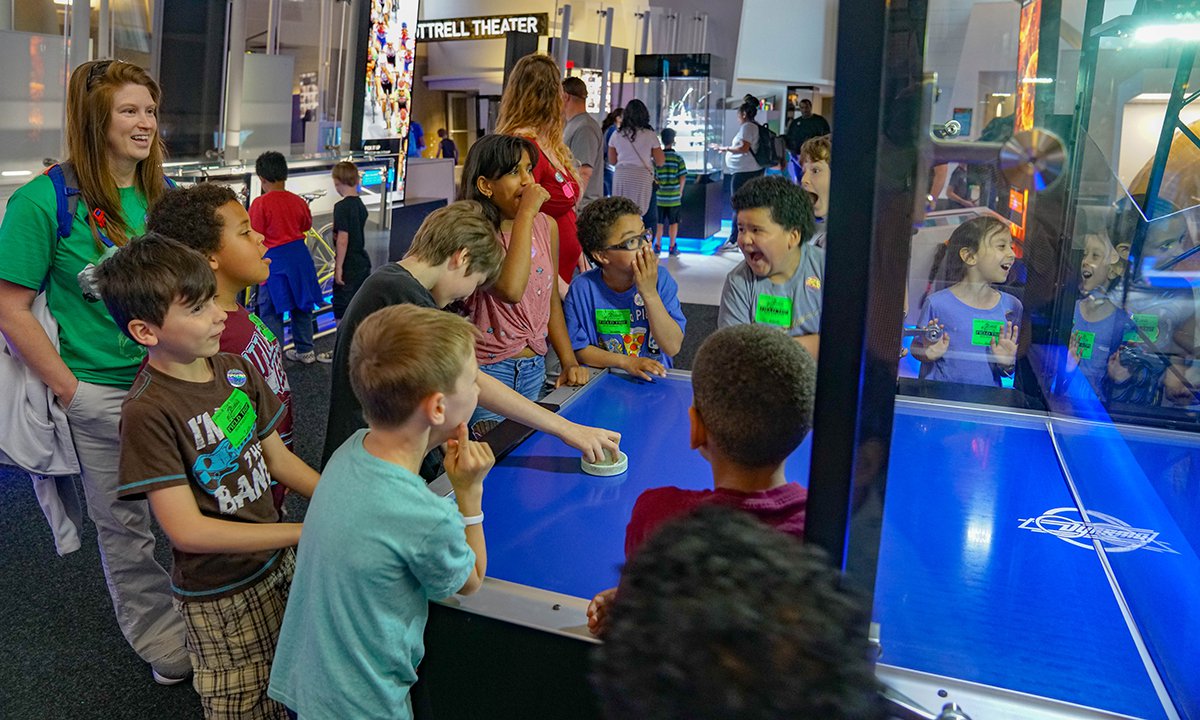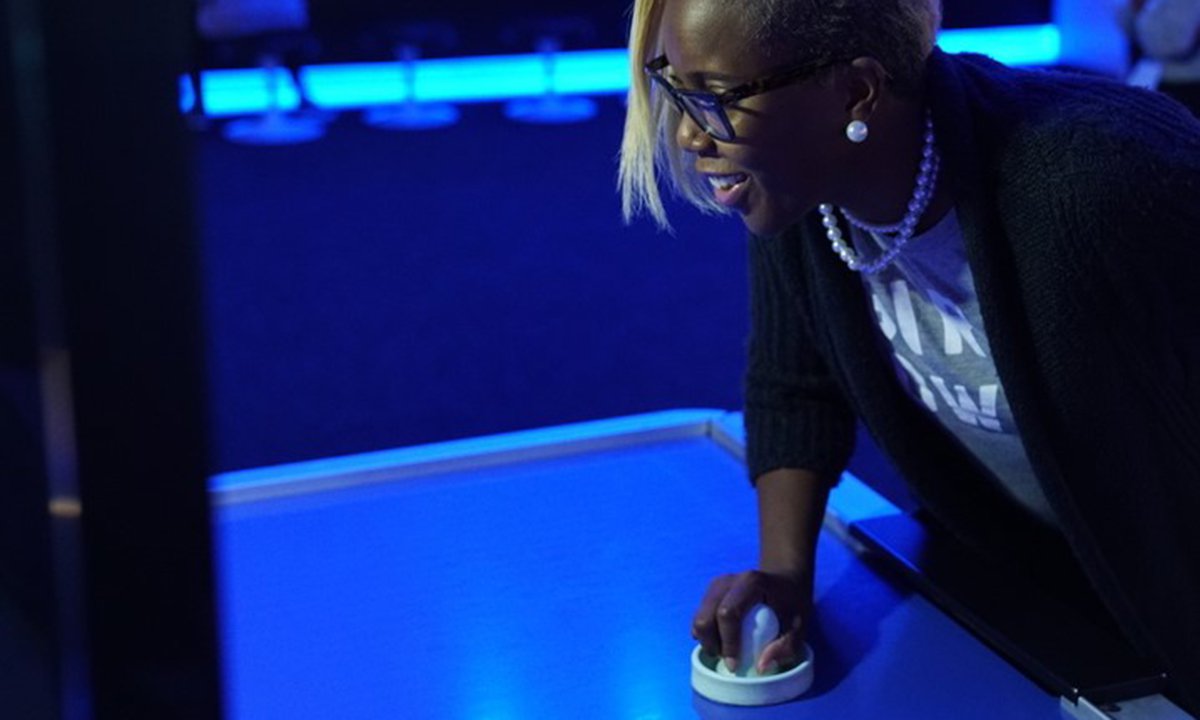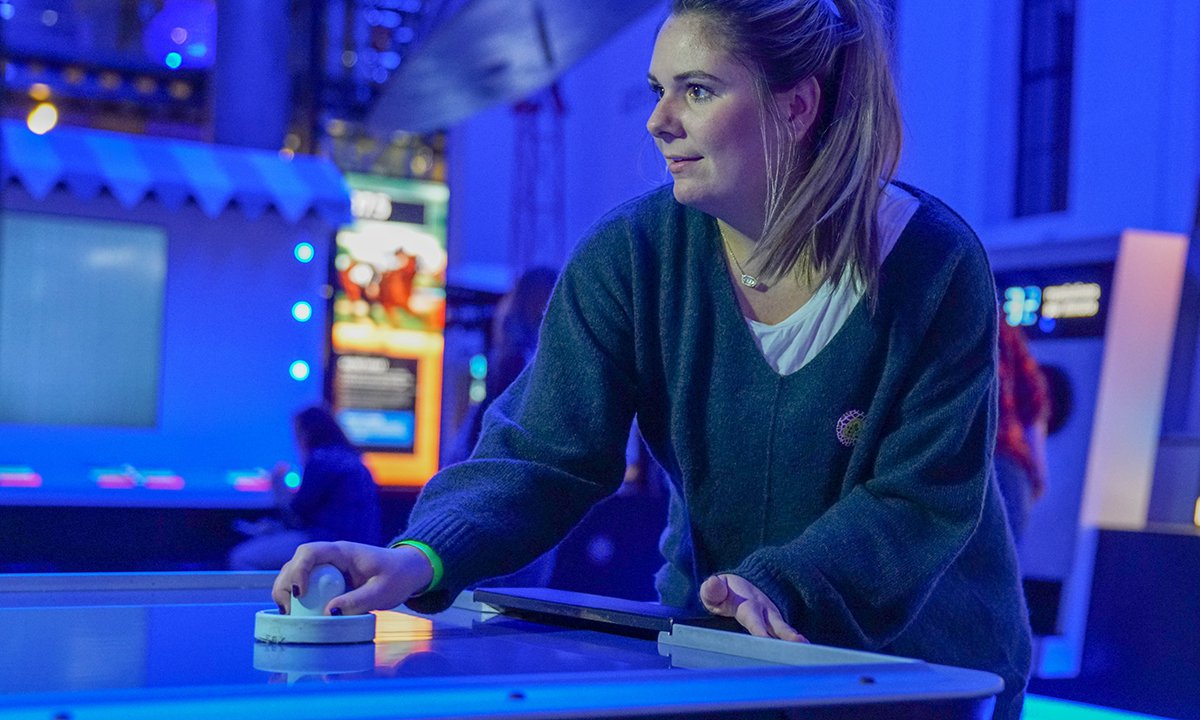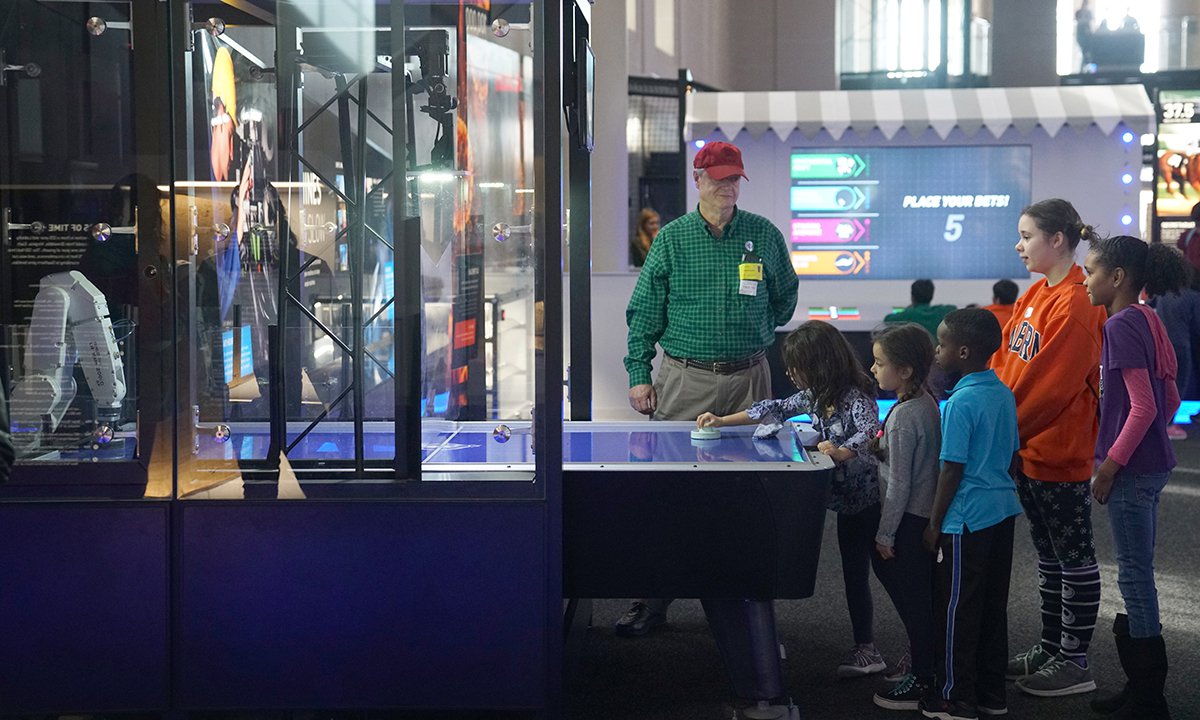Game On: Beating the Air Hockey Robot
If you’ve visited the Science Museum of Virginia in the past five years, it’s likely you tried to score on the air hockey-playing robot. If you haven’t visited the Science Museum, it’s likely you now want to try to score on the air hockey-playing robot.
We use try in both sentences intentionally because even for professional air hockey players (yes, there’s such a thing), it’s not as easy as you may think. As part of the Science Museum’s exhibits team, Blake Forbes has had countless opportunities to perfect his skills over the years. He’s actually pretty good, and he’s willing to share his secret.
But first, to understand how to beat the machine, you have to understand how it works.
The air hockey-playing robot at the Science Museum—officially called the AHB-2000—is one of only four that exist in the world, and only three are available for public use. The first was created to wow the crowd at a trade show.
A semiconductor company called FreeScale hired California-based Nuvation to build the air hockey-playing robot. Nuvation didn’t come up with that idea—they usually stick with consumer, satellite and medical device-type products. FreeScale approached several other product design companies before getting to Nuvation and they all said “no way,” partly because the tradeshow where the item was to be exhibited was only a few months away and partly because games where someone is playing against a robot are rare and take a lot of work!
So why did Nuvation take the gig? Edward Ayrapetian was Principal Design Engineer when the robot was created. He told us during a conversation in 2018 for the ten-year anniversary of the start of the project that it’s because their software, electrical and mechanical engineers like a good challenge. “We like doing these kinds of crazy things.”(They do, in fact, do lots of quirky challenges. Their company has had two top robots in the BattleBots competitions.)
When Nuvation was awarded the project in 2008, Edward said he had never even played air hockey before. The team found out air hockey was a popular sport in the bay area where they are located. In fact, there were professional players who lived nearby. Nuvation purchased the 20-year-old air hockey table used for the prototype from a top-ranked professional air hockey player.
Nuvation created an air hockey-playing robot for the tradeshow, one that strictly played defense to ensure the other player didn’t score. Not only did it win the people’s choice award for the best display at that event, FreeScale loved the design so much it asked Nuvation to take the 3,000-pound system to China for another event.
The exposure drummed up great interest in the technology, and soon the Carnegie Science Center in Pittsburg was calling to place an order. A few years went by and Questacon (a science and technology center in Australia) placed an order. Then, in 2015, the Science Museum of Virginia asked Nuvation to build a robot for its Speed exhibition opening the following year. With that, our Fanuc LR Mate 200iC with a LR Mate R-30iA Controller robot was born!
Edward says they never expected so much interest. “We weren’t marketing or promoting the air hockey robot. We were surprised to hear from any of the museums!”
From the prototype to the first museum robot, the team had to make some adjustments. The tables is still covered with tiny holes that blow air to create a friction-reducing cushion. But, because the interactive had to be safe for display, the team needed to add a barrier preventing guests from getting anywhere close to the robot.
Nuvation used a general-purpose robot arm for the piece the hits the air hockey puck. This type of machinery is most often found in a factory setting where the arm would be programmed to weld, assemble or pick-and-place repetitively by shape or size. Edward said to get the robot arm to play air hockey it took some customization, which had the full support of the manufacturer.
In addition to the barrier to protect guests, the museum-friendly model had to include features the prototype didn’t. That robot had to not only play offense and defense with the puck, it had to retrieve a puck if a lucky player did in fact score against it. It also had to have a mechanism for getting a puck out of the middle of the table. (Interestingly, the puff of air the robot arm blows to get a stalled puck back to its human player was designed and built by in-house staff!)
So, how does the robot arm track the puck? There are several processing units that make up the exhibit: a control board operates the arm and computers track the puck. They “talk” to each other to make the entire system work.
There’s a screen showing guests how the robot follows the movement of the puck using a real-time operating system. It tracks where the puck is on the table using a piece of reflective tape on the top of the little plastic disk. A camera above the table pointing down can “see” the reflection and transmit information from that computer to the one controlling the arm.
How fast is the puck traveling? How far did the puck bounce? How much energy was lost when the puck hit the table edge or striker (the plastic hand-held paddle a player uses to move the puck around the table)? The computer is doing an incredible amount of processing to determine the answers to these questions and more. In fact, it’s sending coordinates to the control board every 10 milliseconds!
Even with all those calculations happening at the same time, and hundreds of games played every day, the air hockey robot beats its human opponent a majority of the time. Not only is the guest almost always the underdog, but the robot is actually only set to perform at 90% capacity. Yes, you read that correctly: it’s going easy on you!
Having the robot score on you (maybe even score three or four times in the 45-second game window) isn’t the hardest part about playing, Edward claims. The most embarrassing aspect according to him is when “it mocks you with its stillness.” Sometimes, he explained, if the person playing against the robot makes a terrible shot, the arm doesn’t even move. It knows there’s no way the shot is going to score and doesn’t bother mounting a defense!
Ok, back to Blake’s secrets for beating the air hockey-playing robot. Blake says the best way to score is to shoot from as close to the middle of the table as you can reach without hitting the protective divider when you extend your arm. The shorter the distance the puck travels, the less time the robot arm has to react. It’s not about hitting it hard, but rather requires a quick flick of the wrist. Then the player must immediately retreat to cover the goal as being closer to the robot’s goal when you shoot means you’re farther away from protecting yours. Even if you score on the robot, the real winner is the one with the most points at the end of the game so defense is key!
There you go. While we feel like we betrayed our beloved robot by sharing the winning strategy, we also want to be sure our guests are happy. Besides, even if you now know how to do it, we suspect you’ll need repeat visits to perfect the technique as consistently as the air hockey-playing robot!
